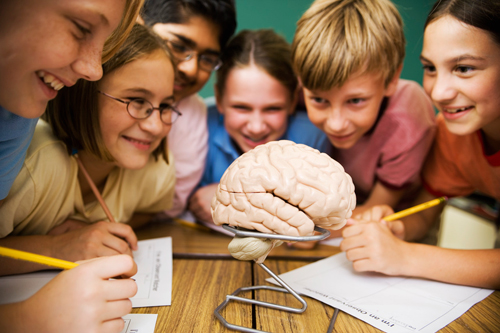When I arrive at my job, several people run to the door to hug me. During each day, at least one person falls out of her chair, someone bursts into tears, and several people fail to complete their assignments. My co-workers drop food on the carpet, flip upside down into headstands, and make fart jokes. Half of them interrupt me with off-topic remarks, and the other half sit in sullen silence. Sometimes they pick the keys off our shared computers.
I wish I were kidding.
Any sane person who worked with people like these might quit. But in my world, this is not only normal but downright healthy. The people I work with are middle school students, and I am the guardian of minds and souls under construction.
While they can be unpredictable in their oddities, my students are also interesting, lively, and brilliant. My work is to accept them as they are, while also helping them grow into everything they can be.
Patience, emotional stability, and flexibility are essentials in my job, but a solid understanding of neuroscience is my sharpest tool. Neuroscientist JoAnn Deak refers to teachers as “neurosculptors” because everything we do—or fail to do—as educators has a long-term impact on our students’ brains.
I stretch my students as much as I can, because the more they do now, the more they will be able to do later in life. During these years, it is truly use it or lose it.
However, while Deak encourages me to feed their intellects, her work has also helped explain my students’ impulsivity and inconsistent decision making, enabling me to develop realistic expectations for their reactions. Now, when I start to utter that classic adult scold: “You should know better!” I check myself, and recognize: actually, they don’t. That’s why they need adults who care in all the right ways.
Mature brains make good decisions when three brain regions work together smoothly. The amygdala initiates a choice, signaling with caveman-like insistence that it is time to do something. It grunts at the cerebral cortex, the eager nerd in our brains, to generate plans and ideas for how to get that something done. Those signals are sorted by the frontal cortex, the bossy front-office executive, that part of our brain that makes the final call about which something is likely to work best—or which somethings seem like a great idea but really must be avoided at all costs.
The typical adolescent brain has plenty of power. Studies have demonstrated that most normally developing brains achieve intellectual maturity around age 15 or 16. Kids this age feel smart, hence the sassing back, the insufferable rolling of the eyes, and their confidence in their ideas, no matter how poor their actual judgment. Adolescents rightly enjoy their intellectual power, even as their ideas are flying off in all directions.
However, the kids in my class (I must remind myself over and over) also have a newly empowered amygdala. The amygdala is a primal, deep-brain structure that cues aggression and fear, but is also crucial to the most basic sort of learning: fear conditioning. Recent MRI studies have demonstrated a swelling in the amygdala starting six months before puberty shows itself. Other studies find that the kids with the largest amygdalae argue more with their mothers. Again, I wish I were kidding.
Smart brain. Intense emotional learning. Only one problem: because the cortex develops from back to front, my students’ full-speed-ahead brains are operating without adequate judgment. The amygdala is shouting at the cortex, “DO something!” The cortex fires off lots of powerful ideas in response. But there is precious little activity in the front of the brain, where wisdom and judgment will one day reside. Hence their occasional brilliance and their equally frequent missteps.
And this is where patience, flexibility, and emotional stability come in. We, the adults in the adolescents’ lives, have to impose judgment from the outside—yet without squashing all the learning, growth, and energy germinating within. My kids need the highest expectations and the most enormous patience I can provide.




6 Comments
Matthew
Dear Launa,
Amen!
Two days ’til my 14 year old returns for 9th grade.
Time spent over the last 60 days on the school’s summer writing assignment?
Five hours – and that’s a generous accounting.
Dane
Having spent 40 years in middle school education I know you speak the truth! Your words are refreshing and encouraging. I will post a link to your good article to my blog. Thank you.
Holly Scott, MBA, MS, LPC
Love your recommendations of patience, flexibility, and emotional stability. Perfect summary of the skills needed to successfully relate to adolescents.
sally
interesting!